
COOKING IN THE TIME OF CORONA
04/03/20 — Ada Broussard
 This week Mackenzie put Cheetos on her stew, proving that you can do anything you want when you're cooking at home, in the time of Corona. Photo and Cheetos topping by Mackenzie Smith.
This week Mackenzie put Cheetos on her stew, proving that you can do anything you want when you're cooking at home, in the time of Corona. Photo and Cheetos topping by Mackenzie Smith.
Hello! Ada here. For those of you who don’t know me, howdy! I’ve worked at JBG for 8 or so years and have had the pleasure of having a kitchen stocked of seasonal vegetables for about that long. I still work for the farm, part time, and when I’m not wearing my JBG trucker hat I’m thinking about cooking at home, meal prepping, seasonal eating, and the current contents of my fridge and freezer. I do this with my friends and family, and also through the lens of my meal prep business, Club Home Made. We usually get together, drink wine, and prep food in community. Of course, these meal prep gatherings are on hold for now, but the home cooking skills we preach are coming in handy these days. Shameless plug: follow us on Instagram for cooking tips and lots and lots of baby goat videos, as of late. Today, I’m putting on my Club Home Made hat and talking about cooking in the time of Corona.
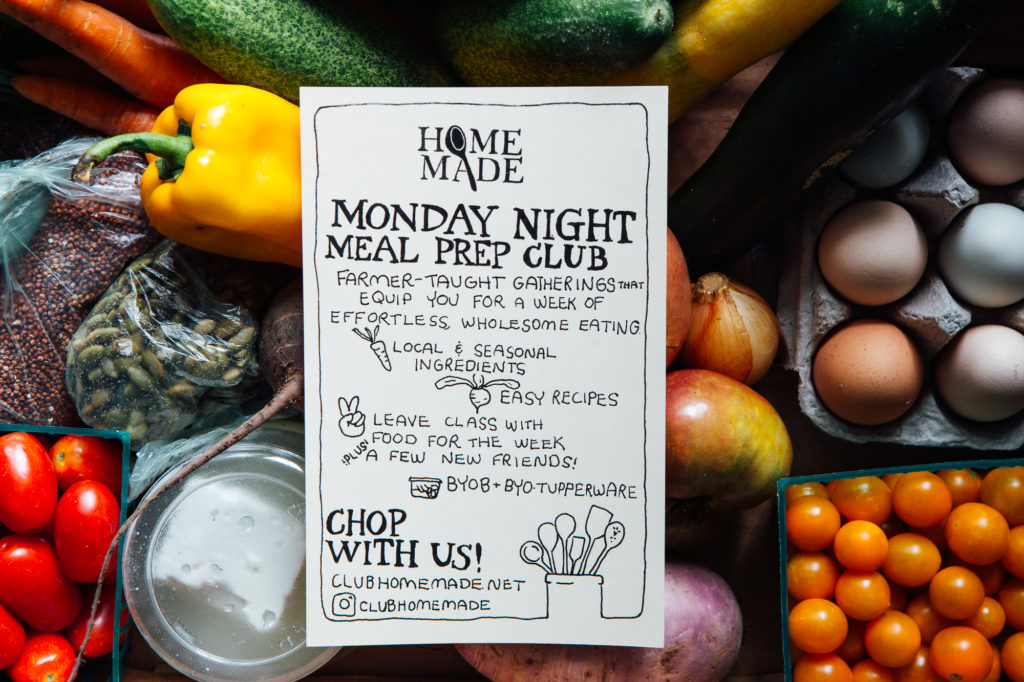
It seems like everyone is cooking at home these days, and while the circumstances surrounding this new food revolution are less than appetizing, the end result is something to marvel. Families are at home with time for slow-cooked soups and also no time for the sudden and urgent need for a quick lunch, with whatever happens to be in the fridge. [Hint, I like to keep tortillas and cheese on hand for an instant quesadilla crowd pleaser. Another go-to snack of mine is some sort of dip made from whatever CSA veggie is lingering in my fridge. Like the beet hummus recipe below.] To all of my friends out there who are also homeschooling their kiddos, I’m sure I don't need to remind you that in addition to being a teacher, you’re also now doing the job of an entire cafeteria staff. How are you doing out there? Remember, there is no shame in eating quesadillas for lunch, everyday. My friend Jessica says she’s cooked more in these last three weeks than she has in the past year. I love to watch Jessica, as well as the entire internet, hone in their knife skills, Instapot settings, and kitchen creativity, and I hope that everyone is having fun (or at least mostly fun) while doing it.
 Here is one of my best friends Jessica - a screenshot I snapped while she was busy cooking in the time of Corona. We were doing a bit of real-time recipe consultation, but the onion glasses were all her idea. Jessica was making venison spaghetti, and apparently there is some for me in the freezer.
Here is one of my best friends Jessica - a screenshot I snapped while she was busy cooking in the time of Corona. We were doing a bit of real-time recipe consultation, but the onion glasses were all her idea. Jessica was making venison spaghetti, and apparently there is some for me in the freezer.
If you’re new to cooking this much, I can honestly say that JBG and Club Home Made are here to support you. Shoot us an Instagram message or email if you have no idea what to do with beets...again, or if you just need some veggie storage tips. The good news is that the fresh vegetables you get from JBG, or any local farm for that matter, should make your job easy. These seasonal fruits and vegetables deserve to be the star of at least some of the meals you prepare. Not only will simple preparations help these vegetables “taste like themselves” as Alice Waters often says, but they will also free up some mental and physical time for you. Shop responsibly at grocery stores and equip yourself with a few basic ingredients that can be combined with a couple of fresh vegetables and herbs, and there are endless ways to deliciously go from hungry to full.
I don’t think I’m alone when I say that this week was a bit of a turning point for me and my household in regards to being isolated - the puzzles seemed a little less fun, the zoom happy hours a little more somber, and my anxiety definitely higher. But you know who isn’t crippled with anxiety or fear right now? All the vegetables that astutely keep doing their thing, responding to the longer sunshine hours and warming soil temperatures. Long walks outside and working in my garden are my happy places right now, and I know everyone is saying it, but it’s beautiful outside. It’s about to be hot as all get-up in Texas, and the cool spring breezes and blankets of wildflowers are as temporal as the JBG’s dark leafy greens and bunched beets. If you’re not outside enjoying nature, I hope you at least enjoy the farm’s vegetables as an extension of the beautiful seasonal shift happening right now. Below are some quick ideas for simple, seasonal dishes that show off our spring harvest and make them taste like themselves.
Chard:
Food writer Tamar Adler taught me a lot about the simplicity of boiling food. (Really, it’s one of the smartest meal-prep moves you can make. I’ve been doing it with potatoes ever this post, but now I boil other things, too.) Bring a salted pot of water to boil, and drop in chard stems that have been chopped to pieces that are about 2 inches long. Once the stems are very tender, take them out. In a separate pan, heat up some olive oil, garlic, and whatever fresh herbs came in your CSA box (chopped). Once the garlic is fragrant, add the drained stems and toss to coat. Salt and freshly cracked black pepper to taste. I trust you can figure out something to do with the silky chard leaves, but it’s the stems that I feel don’t get enough attention.Herbs:
Fresh herbs are a joy to have in the kitchen. They can liven up anything you cook, and turn leftovers into new-overs. The one time I’ve been to the grocery store lately the rice and grains isle was obliterated, except for the lentils. Lucky for me, I love lentils. Boil lentils until tender. (See, more boiling! You don’t have to worry about proportions, just cook like pasta for the easiest treatment.) Drain lentils and mix with chopped herbs of any sort, olive oil, salt, lemon juice, and a couple tablespoons of tahini, if you have it. Want something more substantial? Add crumbles of feta or crispy fried onions on top. Great minds obviously think alike, because after I wrote this bit about herbs, Mackenzie submitted her recipe this week which was another herby-inspired salad. If I want something quick and green to accompany a meal, I finely chop a whole bunch of parsley, stems and all, and mix with olive oil, salt, and lemon juice. Stir in thinly sliced celery or radishes, and maybe add something sweet like cranberries or a bit of honey. Or, blend herbs in soups or dips (see below), or roughly chop and add to a mixed green salad. My favorite herb, by far, is parsley, and let it be known that it will soon be too hot for her tender little leaves. If you haven’t embraced parsley this season, do quickly and with rigor because it will soon be basil-o'clock, which isn’t necessarily a bad thing.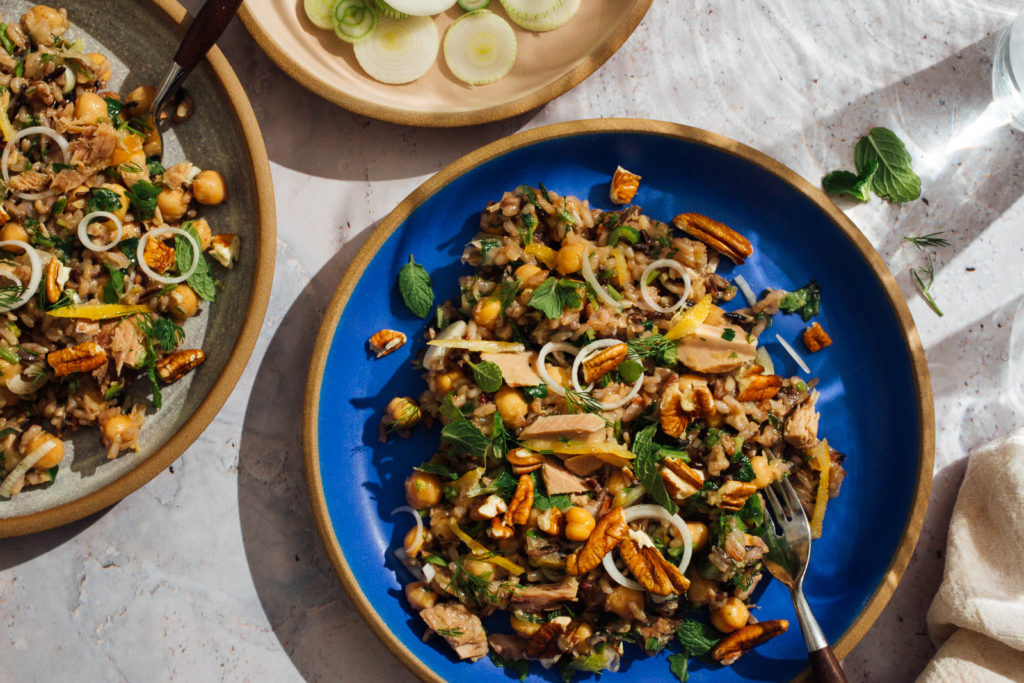 Mackenzie's herby chickpea salad. Recipe is on our homepage, now! Photo by Mackenzie Smith.
Mackenzie's herby chickpea salad. Recipe is on our homepage, now! Photo by Mackenzie Smith.
Spinach:
By far the most popular leafy green. Mild and sweet in flavor, JBG spinach, in my opinion, is best eaten raw. Unlike other bunched greens which are more quickly harvested, tender spinach leaves require a bit more care. Handfuls are harvested by hand, and then eventually need to be individually bagged. Treat them like the jeweled leaves that they are. My favorite spinach salad as of late involves browning some torn mushrooms in lots of olive oil. Once the mushrooms are about done, add some chopped garlic to the pan, cook, then add lemon juice (and maybe some zest?) to the pan. Pour this warm mushroom/oil mixture of the spinach, add cheese and nuts, and enjoy. Ooo! How could I forget? When I feel like putting in the extra mile, I fry up some bacon first, then cook the mushrooms in the leftover grease. Bacon and spinach salads are classic for good reason.If you must cook your spinach, make a simple pureed soup: gently saute an onion and garlic in olive oil, then add the spinach. Cover with delicious broth, or water, and season with salt and pepper. Use an immersion blender or regular blender to blend it up and enjoy the soup as-is on day one, then dolloped with sour cream or yogurt on day two, maybe drizzled with sesame oil, chopped herbs, and croutons on day three, and spooned over rice on day four.
Spring Onions:
If there was ever a harbinger of spring, it would be onions. On a farm on in the wild, you can see wide varieties of onions popping up and gaining momentum. The onions you’re currently receiving will soon size up to be big bulbs which can be stored for the long haul, but these spring beauties are more tender and mild. Add the chopped onion tops to literally anything savory. I can’t think of a dish that green onions wouldn’t enhance. Keeping the bottom of the blub in tact, slice the whole onion in quarters or 8ths lengthwise and cook in some hot oil for the beginning of a stirfry. If you’re ambitious enough to light a fire, rub these with oil and salt, and roast whole. Eat with your hands like a onion-pop, or pull out the steak knife.Carrots:
I’m not sure that JBG does any crop better than we do our carrots. Carrots can be difficult to germinate and are time consuming to harvest, especially when bunched. The very best way to enjoy our carrots, if you’re not crunching on them raw like a bunny, is simply roasted. Unless the carrots are very small, cut them in half lengthwise. Use your (washed) hands and toss with olive oil, salt, and pepper, and roast in a 400 degree oven until tender and beginning to caramelize on the bottom. For the best roasted carrots, rotate your pans in the oven, do not crowd the carrots, and put the cut-side down. In my house, these roasted carrots almost always get eaten right right off the tray, but leftover roasted carrots make wonderful additions to salads, grain bowls, tacos, or curries. Or carrot hummus. The greens make a pretty tasty pesto, as well.*Funny story: I once had another farmer ask me if Brenton walked around the farmers’ markets munching on carrots as a marketing ploy. Of course, the answer is no - they’re just that good!
Collards:
I fell deeply in love with collards several seasons ago while working at JBG. I would eat a bunch, or several, everyday. I used to scoff at the notion of slow-cooking collards and thought a quick saute with a fresh squeeze of lemon was best. (To be clear, this is delicious, too.) But a big pot of collards, slowly cooked till then hit with a dash of vinegar, is so comforting. And don't we all need a bit of comfort, now? Collard's sturdy nature lends them to slow cooking, whether it be by themselves or thrown into a stew or curry.Fennel:
When I used to live in Israel, my friend Tia would shave raw fennel, hit it with some lemon juice and salt, and serve it next to a bowl of yogurt or hummus. This preparation is for the true fennel fanatics. I use fennel in one of two ways: If I’m cooking anything that involves a mirepoix (or holy trinity, as I was taught) I add diced fennel to the mix. This is especially true if the thing I’m cooking happens to be even remotely Italian-ish. Add the fennel just after the onions, and it will melt into whatever dish you’re making and give it a deep, sweet flavor. The other way I love fennel is roasted: cut the bulb into ½ steaks or even quarters and toss with lots of olive oil and salt. Roast in a hot (400ish) degree oven until tender and caramelized. But please don’t turn on your oven just for one fennel bulb - go ahead and roast some carrots or turnips, while you’re at it. Roasted fennel gets added to everything, but especially to a grain salad of sort which I’m oft to make at least once a week. Make tea with the fronds - steep in boiling water and add a bit of sugar, too.Radishes:
Use a mandolin or very careful knife skills to thinly slice your radishes. Toss with olive oil, salt, pepper, lemon, and maybe some herbs, and enjoy a fresh radish salad along with any dinner. Or grate them! Cut radishes, carrots, and even some beets into matchsticks and toss with a yogurty salad dressing for a radish-forward slaw. Put sliced radishes on toast with butter or maybe avocado and some big flaky salt. Radishes are the cucumbers of the winter: their bright and juicy crunch can replace cukes in a cold pasta salad or can be quickly pickled for topping tacos and sandwiches. If you find yourself stumped by radishes, simply slice the ones you get in your CSA box and store them in a closed Tupperware, covered in water. Put the sliced (and ready to go) radishes out on your dinner table with every meal, and you’ll start to see just how useful this crunchy, spicy vegetable truly is.Dandelion Greens:
These bitter and nutritious greens are best eaten when your body is craving a reprieve from the Corona cookies. My favorite way to eat cooked greens is simply sauteed with garlic and served with a big scoop of freshly steamed white rice, cooked in homemade chicken stock or with a heavy helping of quality butter. The bitter greens with the fatty and fluffy rice is often all that I need for a late dinner. If I’m looking to make a more substantial meal out of it, add a fried egg or roasted veggies. Or a simple, parsley salad.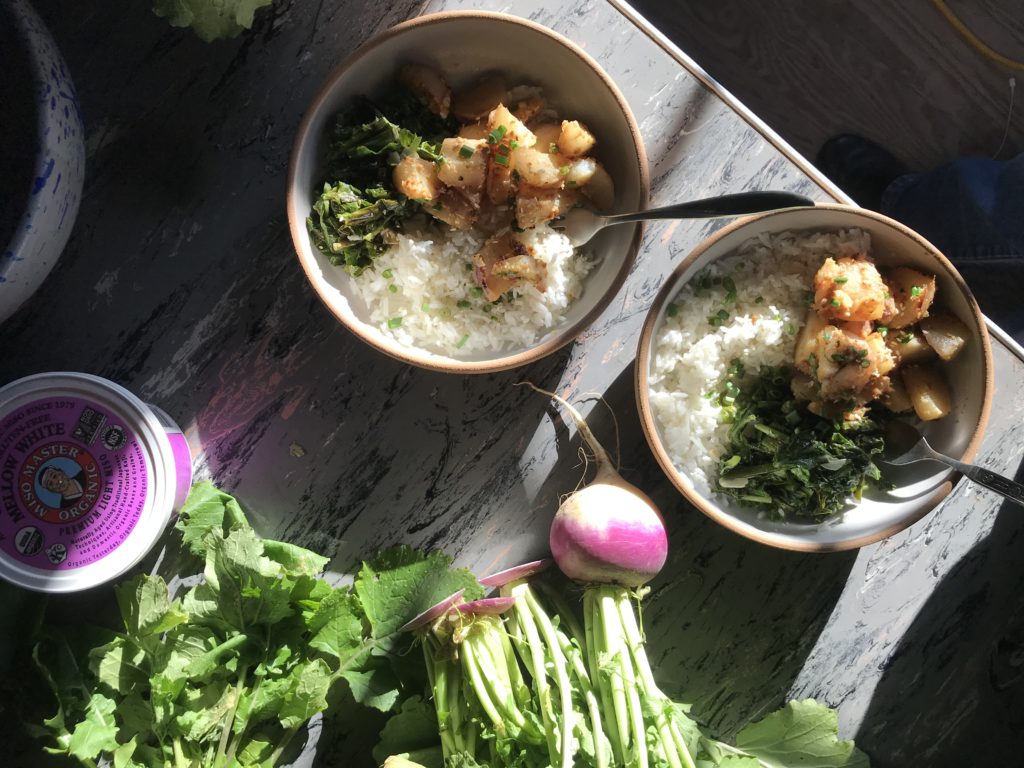 These are technically turnip greens in this picture, but they were cooked just as described in the dandelion greens. Also in this bowl are some miso and butter glazed turnips, recipe below. Photo from Ada's kitchen.
These are technically turnip greens in this picture, but they were cooked just as described in the dandelion greens. Also in this bowl are some miso and butter glazed turnips, recipe below. Photo from Ada's kitchen.
Turnips:
I think turnips are the most underrated vegetable of the fall and spring. These sweet taproots can function like a potato in just any dish you’d like, but really, they’re a bit more forgiving than a potato because they can be delicious raw, al dente, or mixed up with cream, cheese (or cream cheese) for mashed potato sub. My favorite way, as of late, to cook turnips is to braise them with a bit of butter and a bit of miso: In a pan or pot with a lid, toss quartered turnips with a few tablespoons of butter, equal amounts of miso, salt and pepper, and then pour in enough water or broth to barely cover the turnips. Simmer, covered, until the turnips or tender. Once tender, remove the lid and let the water evaporate. Skip the miso and double up on the butter, or simply roast the turnips. Whatever you do, don’t miss out on the sweet and gentle nature of these springtime bulbs. Cook the greens, too.Beets:
Golden, red, or the willy-wonka chioaga, beets are truly a fall and spring crop. If you’ve been a CSA member for a while, you know that we had some major beet crop failure this past fall, and so these spring beets are *hopefully* an exciting addition to your box. If you’ve never blended up your beets to make a delicious dip, perfect for salty chips or a piece of thick crusty bread, go ahead and do that. Recipe below. If I’m roasting just 1 or 2 beets, I try to find a moment when my oven is on anyway, then wrap these up in foil and throw in the back corners until they are soft. My mind was blown when I found out how many restaurants batch-roast beets: Fill up a pyrex or oven safe dish with a bit of water (an inch or so), plop your scrubbed beets in there, then tightly wrap the top with foil. If I’m cooking a bunch (ha!) of beets, I use this method, which yields the most tender, juicy, and delicious beets. The skin sluffs off easily with your fingers, and then you can use said fingers or a bit of freshly roasted beet to blush your cheeks or tint your lips. Who cares that you’re not going anywhere? Treat the greens like the sexy, silky, spinach substitute that they are and cook gently with a bit of garlic and olive oil. Here I am, at one of my Club Home Made gatherings. Mackenzie caught me blushing with beets.
Here I am, at one of my Club Home Made gatherings. Mackenzie caught me blushing with beets.
Beet Hummus:
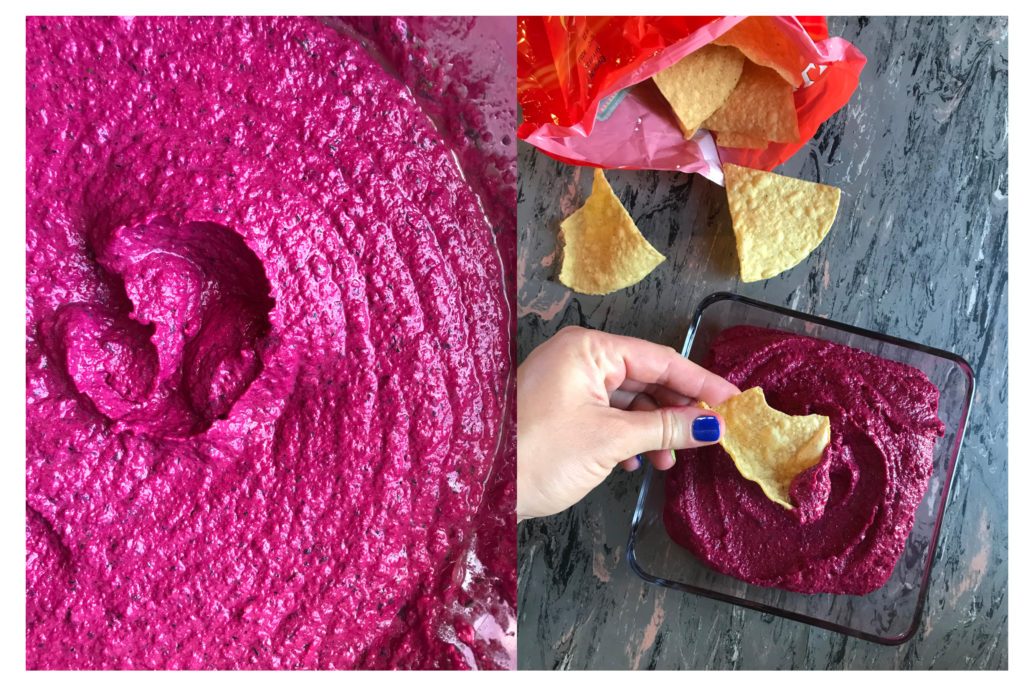
Quarter peeled and roasted beets and put them in a bowl. (They should be very soft. If the skin doesn't come off very easily, they need to go longer.) Add about an equal volume of canned (drained) chickpeas. Canned white beans would work great here, too! I think I used about 6-9 roasted beets.
Add about 3-5 cloves of garlic, more if you have more beets. Add a very generous glug of olive oil. A quarter cup? Add about the same amount of tahini. Maybe a little less.
Add as many chopped "tender" herbs as you feel comfortable with. I used parsley and dill. Honestly, you can go pretty heavy on the herbs. They will help brighten the earthy flavor of the beets.
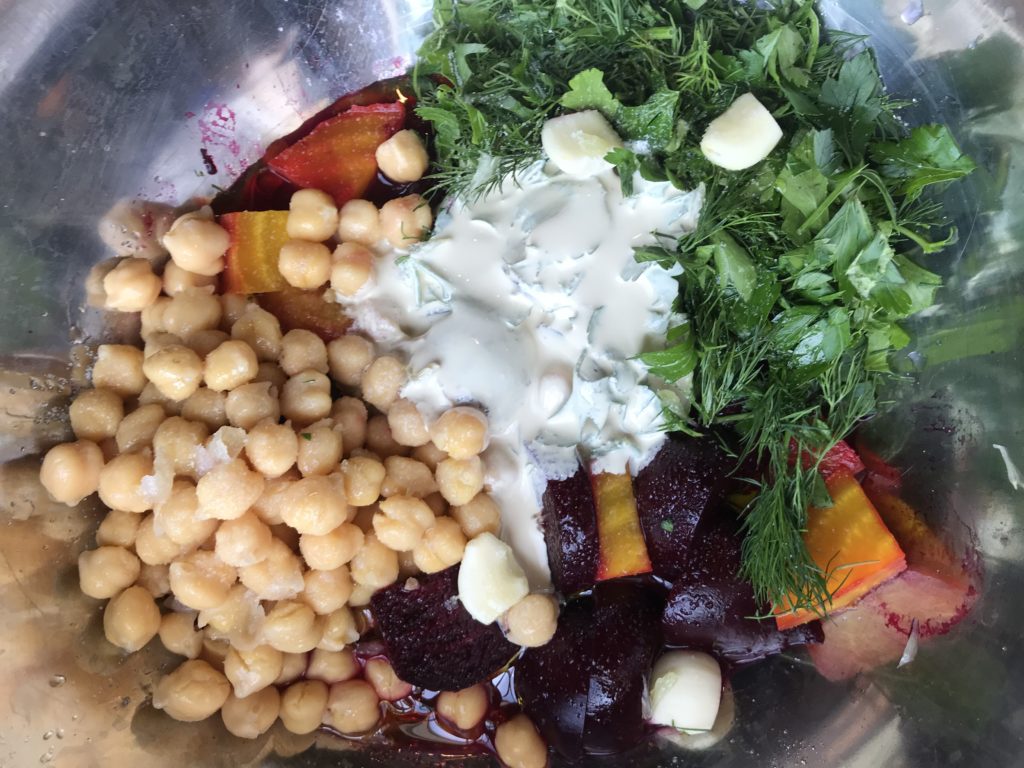
Add a lot of acid: lemon or lime juice if you have it, and maybe some red wine vinegar if you don't. I used lime juice because it's what I had. (Zest, too, if you're feeling fancy!)
Salt!
Blend it up! I used an immersion blender. Taste, and add more salt if it's bland, acid if it's too early, and olive oil if it's too chunky. I needed to add more of all three after my first blend. Serve with tortilla chips, pita chips, or maybe even slathered on a wrap.
I've also made versions of this dip using plain yogurt instead of tahini. It's a creamier dip, and is very delicious! Sub roasted carrots for the beets in either the tahini or yogurt version! Also, if I had a hot pepper (jalapeno or serrano) I would have added some of that to the beet hummus - the spice will help balance the earthiness.






 0 ITEMS IN CART
0 ITEMS IN CART 

